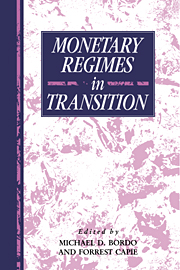Book contents
- Frontmatter
- Contents
- List of figures
- List of tables
- List of contributors
- 1 Introduction
- Part I Commodity money standards in transition
- Part II Successful and unsuccessful adherence to the gold standard
- 5 Spain during the classical gold standard years, 1880–1914
- 6 Canada and the gold standard, 1871–1914: a durable monetary regime
- 7 Australia's payments adjustment and capital flows under the international gold standard, 1870–1913
- Part III Wartime upheaval and postwar stabilization
- Part IV Perspectives on monetary regimes
- Index
6 - Canada and the gold standard, 1871–1914: a durable monetary regime
Published online by Cambridge University Press: 05 May 2010
- Frontmatter
- Contents
- List of figures
- List of tables
- List of contributors
- 1 Introduction
- Part I Commodity money standards in transition
- Part II Successful and unsuccessful adherence to the gold standard
- 5 Spain during the classical gold standard years, 1880–1914
- 6 Canada and the gold standard, 1871–1914: a durable monetary regime
- 7 Australia's payments adjustment and capital flows under the international gold standard, 1870–1913
- Part III Wartime upheaval and postwar stabilization
- Part IV Perspectives on monetary regimes
- Index
Summary
The gold standard era that lasted from 1821 to 1931 was remarkable for the prevailing widespread confidence in the ability of gold and fixed exchange rates to facilitate a smooth adjustment to disturbances in the balance of payments. The durability of this monetary regime varied widely from country to country. Canada provides an example of a country that survived on the gold standard with minimal government intervention from 1870 to 1914. Why did the gold standard work so well for Canadian balance of payments adjustment, and what was the nature of the adjustment process?
In this chapter we argue that the central feature of the Canadian case was the international mobility of capital. Capital flowed freely into the country over the entire growth period, aided by a set of banking institutions that were well suited to service these flows. Capital mobility presents a new challenge to theorists of balance of payments adjustment. The important distinction between balance of payments and balance of trade adjustment is not easily accommodated within the traditional price-specie-flow mechanism. In fact, this traditional view is both logically and empirically unacceptable as an interpretation of the Canadian evidence. Capital mobility raises new questions about the origin of price adjustments and their significance for maintaining balance of payments equilibria. A modern portfolio theory of balance of payments adjustment, we argue, best accommodates the realities of capital and commodity flows. This theory explains the performance of the gold standard in the Canadian case very well. It radically alters the way balance of payments adjustment should be viewed.
- Type
- Chapter
- Information
- Monetary Regimes in Transition , pp. 173 - 200Publisher: Cambridge University PressPrint publication year: 1993



